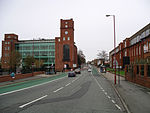Grace Academy, Coventry
Grace Academy is a mixed secondary school located in Coventry, England. It has an expanding sixth form which is part of the North East Federation. It was formerly Woodway Park School and Community College, and was converted into an academy on 31 August 2008 using the same buildings, prior to housing the new academy in new buildings on 24 February 2010The academy was operated by Grace Foundation, a registered charity founded by Bob Edmiston, entrepreneur and founder of the evangelical international charity Christian Vision; however in April 2019 the Grace Trust closed and the academy became a member of the larger TOVE Academy Trust, lead school Sponne School, Towcester, Northamptonshire. According to its Annual Report and Financial Statements to August 2012, the Coventry school received annual government funding of £5,898,000. On 20 August 2013 the school was among those named by The Independent and the British Humanist Association as adopting a policy similar in wording to the repealed anti-gay legislation Section 28. The academy is now fully in line with Coventry LA policies on sex and relationship education, which conform to recent government guidelines. In October 2013, a letter from John Nash, Baron Nash showed that early access results were below the minimal standard with only 32% of pupils achieving 5 GCSEs at grades A*-C including English and mathematics – an 18% drop from 2012. An external education advisor criticised the quality of both teaching and pupil assessment.In March 2014 the school was rated by Ofsted as inadequate and placed into special measures, but the OFSTED report of November 2014 stated that the school was not making enough progress towards removal of special measures. In March 2016 the school was moved out of special measures.
Excerpt from the Wikipedia article Grace Academy, Coventry (License: CC BY-SA 3.0, Authors).Grace Academy, Coventry
Wigston Road, Coventry Woodway Park
Geographical coordinates (GPS) Address Website External links Nearby Places Show on map
Geographical coordinates (GPS)
| Latitude | Longitude |
|---|---|
| N 52.43817 ° | E -1.44582 ° |
Address
Grace Academy
Wigston Road
CV2 2RH Coventry, Woodway Park
England, United Kingdom
Open on Google Maps






